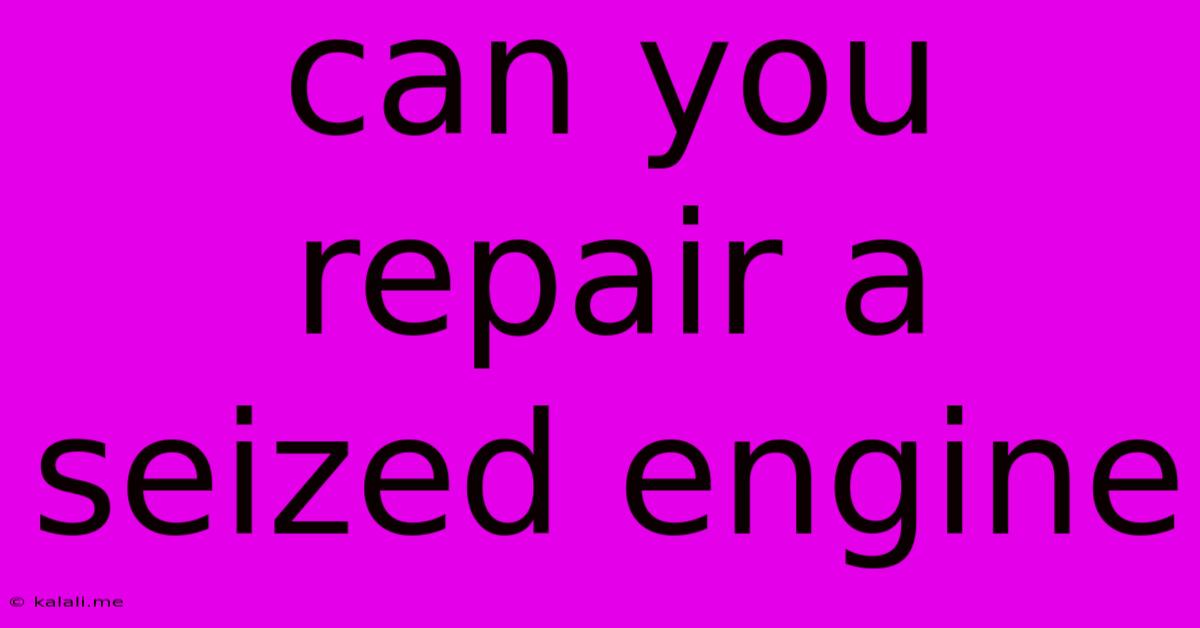Can You Repair A Seized Engine
Kalali
May 25, 2025 · 3 min read

Table of Contents
Can You Repair a Seized Engine? A Comprehensive Guide
A seized engine is a car owner's worst nightmare. That terrifying grinding sound, the sudden loss of power – it signals a major mechanical failure. But before you panic and start budgeting for a replacement, let's explore the possibilities of engine repair. This article will delve into the causes of a seized engine, the potential for repair, and when replacement becomes the more practical option.
Understanding a Seized Engine
A seized engine occurs when internal components become locked together, preventing the engine from turning over. This usually happens due to a lack of lubrication, leading to excessive friction and heat that welds moving parts together. The damage can range from minor scoring to catastrophic failure, impacting various parts like pistons, cylinders, and connecting rods. The severity dictates the feasibility of repair.
Causes of a Seized Engine
Several factors contribute to engine seizure. Identifying the root cause is crucial for determining the repair strategy:
-
Lack of Engine Oil: This is the most common cause. Low oil levels, oil leaks, or a failure of the oil pump deprive the engine of vital lubrication, leading to metal-on-metal contact and eventual seizure. Regular oil changes and monitoring oil levels are essential preventative measures.
-
Overheating: Excessive engine temperatures can cause oil to break down, losing its lubricating properties. This, combined with the expansion of metal components, increases friction and can lead to a seizure. Addressing overheating issues promptly, such as fixing a faulty thermostat or radiator, is critical.
-
Contaminated Oil: Impurities in the engine oil, such as coolant or fuel, can compromise its lubricating capabilities. This contamination can stem from a blown head gasket, a faulty fuel injector, or other issues. Regular oil analysis can help detect contamination early.
-
Foreign Objects: Debris such as metal shavings or fragments from a broken piston ring can enter the engine's lubrication system and cause significant damage.
-
Ignoring Warning Signs: A gradual decline in engine performance, unusual noises, or increased engine temperature should be addressed immediately. Ignoring these signs can allow the problem to escalate into a full-blown seizure.
Is Repair Possible?
The viability of repairing a seized engine depends on the extent of the damage. Minor scoring on cylinder walls might be addressed through honing and an engine rebuild, involving replacing worn parts such as piston rings and bearings. However, severely damaged components like cracked cylinder blocks or severely damaged crankshafts will likely necessitate engine replacement.
Repair vs. Replacement: A Cost-Benefit Analysis
Repairing a seized engine can be a costly endeavor. The cost of parts, labor, and specialized tools can quickly add up. Factors to consider when deciding between repair and replacement include:
-
Extent of Damage: A comprehensive assessment of the engine's condition is crucial. This may require professional inspection and disassembly.
-
Vehicle Value: Repairing a seized engine in an older, lower-value vehicle may not be economically feasible.
-
Repair Costs: Obtain multiple quotes from reputable mechanics to compare pricing and understand the scope of work.
-
Availability of Parts: Finding replacement parts for older or less common engines can be challenging and expensive.
Prevention is Key
The best approach to dealing with a seized engine is to prevent it from happening in the first place. This involves diligent maintenance, such as:
-
Regular Oil Changes: Follow the manufacturer's recommended oil change intervals.
-
Monitoring Oil Levels: Regularly check your engine oil level.
-
Addressing Overheating: Resolve any overheating issues promptly.
-
Regular Vehicle Inspections: Schedule routine inspections to identify potential problems early.
Conclusion:
While a seized engine is a significant problem, it doesn't automatically mean the end of your vehicle's life. The feasibility of repair depends heavily on the severity of the damage and the overall cost-benefit analysis. However, proactive maintenance is the best way to avoid this costly and inconvenient situation. Remember to always consult with a qualified mechanic for a proper diagnosis and repair plan.
Latest Posts
Latest Posts
-
Sarah Jones In The Vampire Diaries
May 25, 2025
-
Do Pedestrians Have The Right Of Way
May 25, 2025
-
How Many Ampere In Car Battery
May 25, 2025
-
Legendaries In Pokemon X And Y
May 25, 2025
-
Can I Substitute Butter With Oil
May 25, 2025
Related Post
Thank you for visiting our website which covers about Can You Repair A Seized Engine . We hope the information provided has been useful to you. Feel free to contact us if you have any questions or need further assistance. See you next time and don't miss to bookmark.